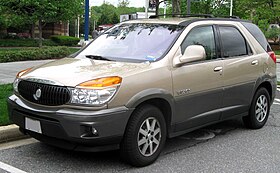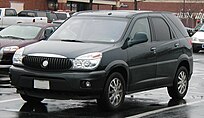Buick Rendezvous
 From Wikipedia - Reading time: 11 min
From Wikipedia - Reading time: 11 min
This article needs additional citations for verification. (April 2010) |
| Buick Rendezvous | |
|---|---|
 | |
| Overview | |
| Manufacturer | Buick (General Motors) |
| Production | February 2001 – December 2006[1] |
| Model years | 2002–2007 |
| Assembly | Ramos Arizpe, Mexico |
| Designer | Elizabeth Wetzel (Interior) (1999)[2] |
| Body and chassis | |
| Class | Mid-size crossover SUV |
| Body style | 4-door CUV |
| Layout | Front-engine, front-wheel drive / all-wheel drive |
| Platform | U-body/GMT257 |
| Related | Pontiac Aztek |
| Powertrain | |
| Engine | 3.4 L LA1 V6 3.5 L LX9 V6 3.6 L LY7 V6 |
| Transmission | 4-speed automatic GM 4T65-E |
| Dimensions | |
| Wheelbase | 112 in (2,845 mm) |
| Length | 186.5 in (4,737 mm) |
| Width | 73.6 in (1,869 mm) |
| Height | 68.9 in (1,750 mm) |
| Curb weight | 4,024–4,272 lb (1,825–1,938 kg) |
| Chronology | |
| Successor | Buick Enclave |
The Buick Rendezvous is a mid-size crossover SUV that was sold by Buick for the 2002–2007 model years. It debuted at the Chicago Auto Show in February 2000,[3] and sales commenced in spring 2001. The Buick Rendezvous and its corporate cousin, the Pontiac Aztek, were GM's first entries into the crossover SUV segment. The Rendezvous featured a four-speed automatic transmission with a V6 engine and optional all-wheel drive (dubbed Versatrak). The SUV used the same platform as GM's short-wheelbase minivans, the Chevrolet Venture and Pontiac Montana. The Rendezvous provided a passenger- and load-carrying capacity not seen in the Buick lineup since the discontinuation of the Buick Roadmaster Estate station wagon in 1996.
Technology and notable features
[edit]
It was Buick's first truck-based vehicle in its lineup since 1923, and the Rendezvous was billed as a combination of the best attributes of a minivan (large cargo capacity, seating for up to seven), a luxury automobile (ride, handling, smoothness), and a sport utility vehicle (truck styling and available all-wheel drive).
The Rendezvous was produced at General Motors' Ramos Arizpe, Mexico, assembly plant, where it shared an assembly line with the Pontiac Aztek. Like the Pontiac Aztek, the Buick Rendezvous is based on a shortened version of GM's second-generation U-platform minivans. In lieu of a traditional four-wheel-drive system, the Rendezvous offered Versatrak, a full-time, fully automatic all-wheel-drive system which provided sure-footed traction in inclement weather and could handle moderate off-road surfaces. The Versatrak system uses hydraulic gerotor pumps and multi-plate clutch packs, instead of the typically used viscous couplings,[4] and is supplied by Steyr-Daimler-Puch AG, under license from McLaren Traction Technologies.[5]
Buick benchmarked its Park Avenue sedan as the prototypical target for ride and handling for the Rendezvous. To provide a luxurious and responsive car-like ride, all Rendezvous models came equipped with a fully independent rear suspension system with aluminum-alloy control arms and crossmember, as well as rear solid disc brakes, regardless of drivetrain.
The instrument cluster of the Rendezvous featured teal-illuminated needles and numbers set in a silver face accented by chrome trim rings that was meant to evoke the luxurious look and feel of an expensive watch or designer bracelet. On the uplevel CXL model, a driver information center on the instrument panel provided the outside temperature, compass, and a trip computer that included readings of fuel economy, driving range, and amount of fuel used; this was also available with the base CX model. An optional second-generation head-up display was also available on both CX and CXL models, while an optional tire-pressure monitoring system provided readings of tire pressure and warned if out of the specified range.
The Rendezvous boasted the ability to carry seven passengers when equipped with a third-row bench, a class-leading feature that Buick brought to market before its competitors, and was able to carry a standard 4-by-8-foot (1.2 m × 2.4 m) sheet of plywood.
In support of the Rendezvous's intended role as a versatile accoutrement for busy people with families, it provided a center console with storage space and power points for a laptop computer as well as separate compartments to hold a purse, a cell phone, pager, or other small items that the owner would want to keep organized and readily accessible as well as an optional rear cargo organizer system and rear seat stereo system controls with headsets.
Safety
[edit]The Insurance Institute for Highway Safety (IIHS) gives the Rendezvous an overall Acceptable rating in its frontal offset crash test for fair structure performance and fair dummy control. However, the IIHS did not perform a side-impact test on the Rendezvous.[citation needed]
Sales success
[edit]The Rendezvous was a badly needed success for Buick, given the decline of its aging customer base, and singlehandedly brought a large number of younger, wealthier "conquest" buyers into Buick showrooms who otherwise would not have considered purchasing a Buick. A major contributor to the Rendezvous's success was an aggressive value-pricing strategy that made the Rendezvous US$6,500 less than a comparably equipped Acura MDX and US$8,000 less than the Lexus RX. The Rendezvous handily exceeded GM's predictions of 30,000 to 40,000 units a year by a large margin, which helped offset the poor sales of its closest relative, the Pontiac Aztek.[citation needed]
Year to year changes
[edit]2002
[edit]- Available in CX and CXL trims; front-wheel drive available on CX only.[6]
- Standard five-passenger seating with available seating for six or seven and stowable third-row seat (except on CX AWD).
- Standard equipment on all models includes power windows/locks/mirrors, cruise control, CD player, leather-accented steering wheel with radio controls, cloth seats (with manual four-way position and lumbar control for front seats and foldable/removable second-row seats), floor mats, traction control (on FWD models), anti-lock brakes, daytime running lamps and fog lamps, roof rack, remote keyless entry, deep-tinted glass (except front doors and windshield), lockable center console and glovebox, 16 × 6.5-inch wheels (steel on CX FWD, brushed aluminum on AWD), cargo net, and cargo privacy cover.
- Optional on CX and standard on CXL are a garage door opener, rear cargo mat, driver information center (with tire-pressure monitoring system on later models), rear parking sensors, and except on CX AWD, power seats with six-way adjusters, memory seats, second-row footrests, heated memory mirrors, leather seats with heated first row, and rear-seat audio controls.
- Exclusive to CXL are electronic dual-zone climate control with pollen/odor filter, auto-dimming interior rearview mirror, and optional chrome-clad aluminum wheels and head-up display.
2003
[edit]- Available trims now include CX, CX Plus, CXL, and CXL Plus in both FWD and AWD.[7]
- An overhead DVD entertainment system with LCD screen and two pairs of wireless headphones is optional on CXL, but is not available with the sunroof.
- Traction control, ABS, and side-mounted airbags are now optional on FWD CX models.
- Six-way power seats are now optional on CX and standard on CXL.
- Five-passenger seating is standard on all models except on CXL Plus, where seven-passenger seating is standard. Six-passenger seating is optional on CXL.
- A cargo net is now optional on all models.
- A trailer hitch/harness is now available in addition to the trailering preparation package; both are available on all models except base CX.
- Cross bars for roof rack are now optional on base CX models.
- A cloth-and-leather-trimmed instrument panel cluster is now available on CX; interior now has three instead of four 12-volt power outlets.
- A tire-pressure monitoring system is standard on all CXL models.
- A manual dual-zone HVAC system is now standard on CX Plus, CXL, and FWD CXL Plus models. AWD CXL Plus models feature automatic dual-zone climate control, while base CX models still feature single-zone climate control.
- Later models now have a release button on the liftgate handle.
- XM Satellite Radio is now offered for the contiguous United States.
2004
[edit]- Front turn signal/parking lights have been changed to clear from the previously used amber.[8]
- A 3.6-liter aluminum-block DOHC V6 with variable valve timing is now available on AWD CXL models.
- The Ultra is added as a top-line model, with all comfort options, 17 × 6.5-inch aluminum wheels, leather and ultrasuede seating, leather-wrapped steering wheel with faux woodgrain accents and chrome Buick tri-shield, faux woodgrain interior trim, 3.6-liter V6, and all-wheel drive standard.
2005
[edit]- The Ultra is now available in front-wheel drive in addition to all-wheel drive.[9]
- The 3.6-liter V6 is now available on FWD CXL models.
- Seventeen-inch aluminum wheels are now standard on all models.
- A touch-screen radio with DVD-based navigation system is now available.
- CXL models now feature faux woodgrain accents on the steering wheel and interior trim.
- The right front passenger seat now features a passenger sensing system.
2006
[edit]- CXL Plus replaces Ultra as the top model.[10]
- A suite of sound-deadening features called QuietTuning is now standard on all Buick models, including the Rendezvous. The QuietTuning suite consists of laminated front door glass, revised foam sealing for the outside mirrors and door handles, and denser sound-absorbing material inside the hood, on the firewall, and within the instrument panel.
- OnStar is now standard on CXL models.
- The 3.5-liter V6, which is used in the 2005 U-platform minivans, replaces the 3.4-liter V6.
- Grille now has a chrome Buick tri-shield.
- A black-faced instrument cluster replaces the all-silver one used in prior years (2005 in some models).
2007
[edit]- OnStar Direction and Connections with turn-by-turn navigation.[11]
- Available only in front-wheel drive with 3.5-liter V6.
- Cassette player discontinued.
- Last model year for the Buick Rendezvous.
Sales
[edit]| Calendar year | US Sales[12] |
|---|---|
| 2001 | 31,754 |
| 2002 | 61,468 |
| 2003 | 72,643 |
| 2004 | 60,039 |
| 2005 | 60,589 |
| 2006 | 45,954 |
| 2007 | 15,295 |
References
[edit]- ^ "Buick dealers want cash to stock Rendezvous - ProQuest". www.proquest.com. Retrieved November 7, 2024.
- ^ "Elizabeth Wetzel". December 13, 2005.
- ^ "Here's to you: the Rendezvous, Daewoo and Subaru". www.wardsauto.com. Retrieved November 7, 2024.
- ^ "2002 Buick Rendezvous Program #2023". MotorWeek. Retrieved November 7, 2024.
- ^ "GM to Offer All-Wheel-Drive System on New Buick Rendezvous". www.theautochannel.com. Retrieved November 7, 2024.
- ^ "mediaOnline". web.archive.org. October 25, 2011. Retrieved November 7, 2024.
- ^ "mediaOnline". web.archive.org. October 25, 2011. Retrieved November 17, 2024.
- ^ "mediaOnline". web.archive.org. October 25, 2011. Retrieved November 17, 2024.
- ^ "GM 05 Buick Rendezvous". web.archive.org. October 25, 2011. Retrieved November 17, 2024.
- ^ "mediaOnline". web.archive.org. October 25, 2011. Retrieved November 17, 2024.
- ^ "mediaOnline". web.archive.org. October 25, 2011. Retrieved November 17, 2024.
- ^ "GM US Data Book 2005". autointell.com.
External links
[edit]- Buick Rendezvous Official Web Page
- Buick Rendezvous from TopSpeed
 KSF
KSF
